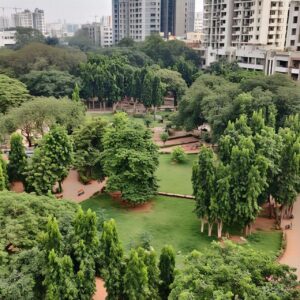Once celebrated as the Garden City of India for its lush parks and tree-lined avenues, Bangalore now grapples with the challenge of preserving its green heritage amid rapid urbanization and technological growth.
Recognizing the environmental and health implications of shrinking green cover, Bangalore has made conscious efforts to promote green spaces and urban forestry through policy initiatives, community engagement, and sustainable planning.
This blog explores what green spaces and urban forestry mean, how Bangalore is working to preserve and expand them, the challenges involved, and what the future holds.
Green Spaces and Urban Forestry
Green spaces refer to parks, gardens, tree-lined avenues, wetlands, and recreational areas within cities. They provide ecological benefits like reducing air pollution, controlling urban heat, and enhancing mental well-being.
Urban forestry, on the other hand, involves the planning, planting, and management of trees and forests in urban areas. It is a science-based strategy to improve biodiversity, air quality, and urban aesthetics while making cities more resilient to climate change.
Translating these principles into action, Bangalore has initiated a range of projects to reclaim its identity as a green city.
The Need for Green Interventions in Bangalore
Bangalore’s meteoric growth as a global tech hub has brought with it issues like:
-
Deforestation for real estate and infrastructure
-
Air and water pollution
-
Increased urban heat islands
-
Poor waste management
-
Traffic congestion and reduced biodiversity
Consequently, the green cover in Bangalore decreased from 68% in the 1970s to less than 20% in recent years. These alarming statistics have prompted civic bodies, NGOs, and citizens to take active steps to restore ecological balance.
Government Initiatives to Revive Green Spaces
1. Bangalore Smart City Green Initiatives
As part of the Smart Cities Mission, the Bruhat Bengaluru Mahanagara Palike (BBMP) and Bangalore Smart City Ltd. have taken measures to:
-
Rejuvenate lakes like Bellandur and Varthur
-
Plant trees along arterial roads
-
Create urban forests within IT corridors and residential zones
-
Introduce vertical gardens and green walls on flyovers and metro pillars
These projects not only add greenery but also mitigate dust and carbon emissions, making the city more breathable.
2. The Tree Census and Miyawaki Forests
To track and manage tree cover, the BBMP undertook a digital tree census using GIS mapping. This initiative has allowed for better monitoring of green zones and planning of new plantations.
Moreover, Bangalore has embraced the Miyawaki method of forest development—a technique that allows for dense, native forests to grow rapidly on small plots. Areas in HSR Layout, Whitefield, and Hebbal have witnessed the emergence of these mini-forests, which serve as carbon sinks and biodiversity havens.
3. Lake Development and Wetland Conservation
Bangalore, once home to over 1000 lakes, has seen many of them dry up or get encroached upon. However, over the last decade, efforts have been made to rejuvenate lakes with walking paths, tree plantations, birdwatching zones, and waste filtration systems.
Lakes like Kaikondrahalli, Puttenahalli, and Jakkur are shining examples of how public-private partnerships can restore ecosystems. Wetland conservation has emerged as a core strategy for maintaining Bangalore’s hydrological balance.
The Role of Citizen Participation and NGOs
While government initiatives have laid the foundation, citizen involvement has been the real game-changer. Several non-profit organizations and community groups actively contribute to Bangalore’s green revival.
? Examples of Civic Engagement:
-
SayTrees and TreesForFree regularly organize tree plantation drives across the city.
-
Hasiru Dala, a social enterprise, promotes urban composting and rooftop gardens.
-
Whitefield Rising focuses on lake conservation and waste segregation.
Through transitive collaboration between residents and authorities, these movements have transformed barren patches into green zones and educated the public on sustainable living.
? Green Spaces and Public Health
Scientific studies have shown that green urban environments directly impact public health. In Bangalore, green spaces:
-
Reduce stress, anxiety, and depression
-
Improve air quality, thereby lowering respiratory illnesses
-
Encourage physical activity and social interaction
-
Reduce noise pollution
Given the rising health concerns in polluted urban centers, Bangalore’s focus on green zones contributes not just to ecological sustainability but also to mental and physical well-being.
Challenges in Sustaining Green Growth
Despite considerable efforts, several challenges persist:
1. Urban Sprawl
The growing demand for real estate continues to pressure forested zones and lakebeds, especially in peripheral areas.
2. Lack of Coordination
Overlapping responsibilities between agencies like BBMP, BDA, and KSPCB often lead to delays and project inefficiencies.
3. Pollution and Waste
Pollution of water bodies and improper waste disposal hinder the rehabilitation of natural ecosystems.
4. Funding Constraints
Sustaining urban forestry projects requires ongoing investment, which is sometimes deprioritized amidst competing infrastructure demands.
Bangalore’s Sustainable Urban Future
Despite these challenges, Bangalore continues to serve as a model for urban greening. Its efforts are now being replicated by other Indian cities, and global bodies have acknowledged the city’s environmental push.
Moving forward, experts suggest:
-
Integrating green planning into urban policies
-
Encouraging green building architecture
-
Incentivizing rooftop gardens and community parks
-
Strengthening environmental education in schools
A sustainable Bangalore is one where nature and urban development coexist, supported by policy, innovation, and public participation.
Conclusion
In conclusion, Bangalore’s efforts in promoting green spaces and urban forestry reflect a deep commitment to sustainable development. Through a combination of government policies, civic engagement, technological innovation, and ecological awareness, the city is gradually reclaiming its green heritage.
While challenges remain, the positive steps taken so far offer a blueprint for other cities aiming to balance growth with environmental responsibility. With continued collaboration and innovation, Bangalore has the potential to once again be the Garden City in both name and practice.


